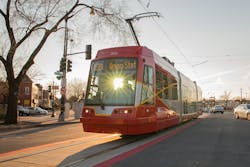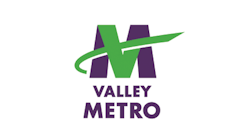Cities including Washington, D.C., Cincinnati and Kansas City have systems that just launched streetcars and others set to launch soon, putting streetcars back on city streets for the first time in decades and in Phoenix, the successful light rail line was extended, allowing for access to larger areas. Each project worked around obstacles that arose, all with the goal of making cities more connected.
The DC Streetcar Looking Toward the Future
In the District of Columbia., the DC Streetcar began operations in February 2016. The project took a little over a decade to plan, construct and test. The District of Columbia saw its last streetcar operation 54 years ago. Terry Owens, the public information officer for the District Department of Transportation (DDOT) said that the project has cost approximately $200 million dollars, with funding covered by the DC general fund.
The DC Streetcar operates 6 days a week, offering extended hours on Friday and Saturday night. Currently there are five cars being operated, with each car holding around 120 passengers.
In launching the project there were obstacles to overcome. Owens said that for future projects, or if anything could have been done differently, DDOT would have enhanced internal staff capacity earlier in the process.
“Management and planning were among the major obstacles facing the project,” explained Owens. “When Mayor Muriel Bowser was elected she brought in new leadership including DDOT Director Leif Dormsjo. The leadership change resulted in the hiring of a more experienced team to address long standing problems. The Bowser administration successfully launched the system in Feb. 2016.”
DDOT selected RATP Dev America to run operations and maintenance on the streetcar, with an initial contract of eight years. Catherine Chardon, CEO of RATP Dev America said their team was exited to take on a project of this historic level and working.
“The most exciting thing for me is to be building a partnership with the city. This is a symbolic project in the nation’s capital and it was great to be selected. In choosing RATP Dev, the city recognized our worldwide expertise and the operating know-how of our local teams. Both of these things mean a lot to me personally. We want to use our global experience to deliver with excellence at the local level,” said Chardon.
To get riders excited about the streetcar, DDOT and RATP Dev America connected with the public and offered free rides.
“Public outreach includes attending local community meetings, participating in community events, and promoting DC Streetcar through partnerships with sister agencies,” said Owens. “Our outreach strategy is also built around social media. For instance, all DC Streetcar related promotion and safety videos are available on YouTube. We have an active presence on Twitter, Facebook and other DDOT social media platforms.”
Chardon said that the city decided to wave fares for the first six months. “This ensures that everyone has the opportunity to try the streetcar for daily commuting and for recreational trips. We hope individuals as well as families will try out the streetcar.”
Since opening, the DC Streetcar has furthered the city’s transportation network and there are expansion plans in the future. Owens said that the businesses and residents that occupy the corridor where the streetcar operates have been supportive of the project.
“The streetcar provides access to Union Station where passengers can connect to MARC, VRE, and Amtrak commuter rail services, many intercity bus lines, DC Circulator bus, and the Metro system,” said Owens. “The proposed expansion of the DC Streetcar system would provide a second connection to the Metrorail at the Benning Metro Station.”
Elisabeth Borne, CEO of RATP Group, said that since opening the city has been a forefront of the project. “All elements of the DC Streetcar were customized to fit with the culture of the city. The people who work on the streetcar are local. The color red is the color used by the city. The logo incorporates the city’s color as well as three stars that represent the flag of Washington, D.C.”
Valley Metro Growth to Reach Larger Ridership
Valley Metro had two extensions that opened within six months of each other. The first opened in August 2015 in downtown Mesa, called the Central Mesa Light Rail Extension (CME) and the second opened in March 2016 in Phoenix, the Northwest Extension. Scott Smith, interim CEO for Valley Metro says that the Mesa line was especially significant.
“That was a big deal because it went right through downtown. That was budgeted at $200 million and came in at $174 million,” said Smith.
The Mesa line was funded primarily through FTA’s Small Starts.
Tom Trimble, senior operations manager for Southwest District of Kiewit Infrastructure West Co. said that previous work was one of the reasons Kiewit was chosen for Mesa. “The CME was a design–build contract, which means we had to leverage its experience and expertise to develop a technical approach that best aligned with the goals of the project. The contract was awarded based on scoring 65 percent on the technical proposal and 35 percent on the price proposal.”
“The second was an extension on the west side of our line and budgeted at $325 million and opened in the middle of March 2016,” Smith said.
Eric Halvorson, vice president transport west regional manager for Parsons, said that they were selected for the light rail extension projects for a variety of reasons, “Parsons has been local to the Phoenix area as one of the leading civil and transportation engineering consultants and has contributed too many local signature projects that have enabled the growth of the region. We were also involved with the customer on the original LRT program that constructed the first 20 miles of light rail in metro Phoenix.”
Smith said that each line required a different approach to planning. “Going through Mesa, the downtown is a very main street town with old shops. So we were very sensitive to not running industrial line through what was a very traditional downtown. So if you look at the stations and the platform artwork we integrated historical references, there very different than on the rest of the system. Then when you go into downtown we completely changed the nature of light rail construction, with just the physical look of rail. There’s no curves, there’s historical light posts that are used instead of regular catenaries. Just the whole look done through downtown was done to try and make a statement. It’s one thing I’m proud of, I was the mayor of Mesa, when we planned that and built that, I think we achieved what we wanted to.”
“The light rail is mostly down the center of the city of Mesa’s main street through downtown. Parsons worked with the city of Mesa as well as individual artists at each of the station locations to highlight the rich cultural history of the area, deliver reflections on the unique local character of the neighborhoods surrounding the stations, and offer an opportunity to for patrons to embrace the station design as part of their neighborhood,” explained Halvorson.
“Northwest was a very different environment, it was more of a suburban urban/environment with lot of older neighborhoods and a lot of apartment complexes and suburban high density. So going through on an older street we spent a lot of time and effort working with that, building walls and they were done in a very decorative manner,” said Smith.
For the Northwest extension, the community was included in designing the stops, including a group of school children who created the artwork for one stop.
Throughout the construction of both lines, effort was made to include the public and minimalize the impact on the community. Halvorson said that Parsons hosted public events and maintained constant communication on all aspects of the LRT. Kiewit also featured “no work” periods during the peak winter season — insuring that local businesses would not be impacted.
Trimble said that the overall CME project ended up being completed over seven months ahead of the original revenue service date. “The project proved to be a successful collaboration of teamwork between Valley Metro, the city of Mesa, community stakeholders and the Kiewit team. Working together, we were able to deliver the final project below the original budget and complete all scopes of work seven months early.”
Both projects have seen successful ridership, increasing 20% yearly. Smith says that Valley Metro has future expansion plants currently in the early process.
Cincinnati Streetcar Set to Launch
The Cincinnati Streetcar was another instance where a streetcar returns to the city; the last streetcar for the city retired 65 years ago. The streetcar is a project of the city of Cincinnati. Rocky Merz, director of communications for the city, said that funding was applied for, eight years ago.
“The city applied for federal grants when available after the mayor and city council in office in 2008 decided to pursue the project. Local funds were made available through the city’s capital projects budget,” said Merz.
When the streetcar launches, Merz said that they will operate every 12 to 15 minutes. Using two or three of the five cars in use at one time. They’ve estimated that the total potential passenger count is 154 per car.
Merz said that biggest obstacle Cincinnati faced was ensuring that stakeholders — especially ones who would be directly impacted by ongoing construction — had an understanding of the project and became engaged. To encourage engagement the city of Cincinnati worked on public outreach.
“By putting together a comprehensive public engagement effort that included everything from a member of the team personally visiting every office, retail, and residence affected by the construction,” explained Merz. “To using every available existing communication network through press releases, a construction newsletter, social media and a new Web-based tool Roadmap Cincy. The team focused on getting the word out on the project.”
Part of the construction contract required the contractor to maintain a 24/7 streetcar help line.
Merz said, “Additionally, more conventional tools included a monthly communication and stakeholder meeting focusing on informing and receiving feedback from those affected by construction. A regular monthly city council reports, using monthly PowerPoint presentations and publishing a project monthly report and posting everything on a dedicated website.”
In mapping the 3.6-mile route the city looked to making easier access for business. The route also connects to the city's principal bus transfer location. In April of 2016, the city accepted the construction of the infrastructure as complete — on-time and on-budget.
“On Wednesday, May 4, the city received the last of the five streetcars that purchased from CAF USA,” said Merz. “We are in the process of preparing and testing the cars for burn-in and conditional acceptance.”
Jitendra Tomar, vice president of marketing and business development for CAF USA, explained that CAF’s unique streetcar design was the reason that they were selected to provide the cars.
“We have 100 percent low-floor, and 100 percent means that you can walk from one end to the other without any steps. So CAF was able to deliver cars to Cincinnati and Kansas City at the same time,” explained Tomar. The Kansas City Streetcar opened on May 6. “This is the first-ever 100 percent low-floor streetcar in the U.S. It complies with all U.S. safety standards and regulations, so this is the car that we adapted from the European market for the U.S. market.”
Tonia Crosby, documentation and DBE administrator for CAF USA said that the streetcars are able to integrate with the community. “Many are the aspects are customizable, such as the colors. Cincinnati their colors are orange to fit with the theme. The nose of the car is how they want the car to look. The seating is going to be along the side and the number seats and number of wheelchairs spaces that they want. If it’s a biking community the number of bike spots they would like. All of that is customizable to the city and their needs.”
Tomar said that the streetcars were designed to blend into an urban setting. He said that while many agencies in the U.S. look to have bigger vehicles, light rail and streetcars are sleek. “What CAF did for KC and Cinci, we have four doors on one side: two double doors and two single, so that means eight doors per car. All doors are ADA accessible.”
Merz said that the Cincinnati Streetcar will be operated by the Southwest Ohio Regional Transit Authority (SORTA) and Transdev was contracted for a turn-key operation.
“Cincinnati Streetcar is on schedule in the process of receiving Safety and Security Certification to begin service from the State Safety and Security Oversight Officer at the Ohio Department of transportation in September of this year,” said Merz. “SORTA is the lead in that effort with consultant support from TRA."







